ASUS K53E: Testing Dual-Core Sandy Bridge
by Jarred Walton on April 8, 2011 1:00 AM EST- Posted in
- Laptops
- Intel
- Sandy Bridge
- Asus
General Performance – Dual-Core Sandy Bridge vs. the World
So now we get to the numbers, and this is where some of the competing solutions will really take a beating. Let’s just cut straight to the chase and look at the graphs. We’ve highlighted the K53E in our standard bright green, with the ASUS U41JF in black, Apple's dual-core i5-2415M MBP13 in gold, and the quad-core i7-2820QM in yellow.
One interesting piece of information prior to the benchmark discussion is that despite having a theoretical maximum Turbo speed of 3.2GHz, we rarely see the i5-2520M hit that mark in testing. Using CPUID’s TMonitor utility, in the single-core Cinebench result we see both cores fluctuate between 800 to 3100MHz. It appears the Windows task scheduler isn’t quite sure how to best distribute the load, which is a common problem. However, in the multi-threaded Cinebench test the two CPU cores run at a constant 2.9GHz, as expected.

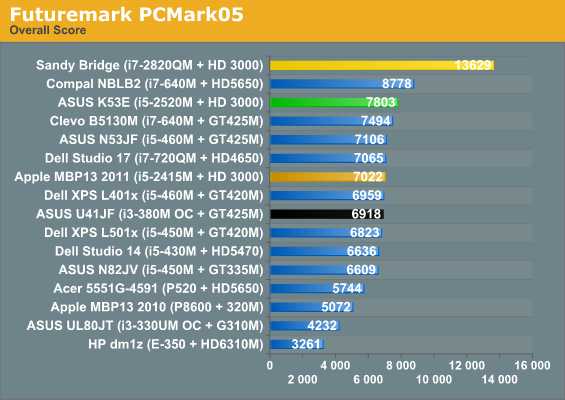
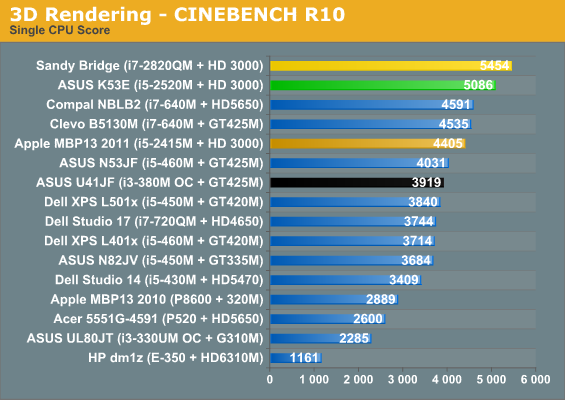
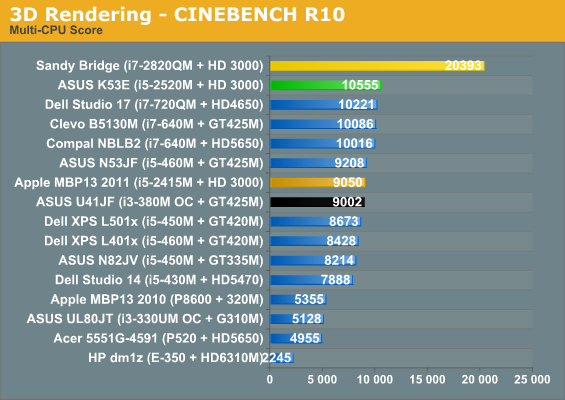
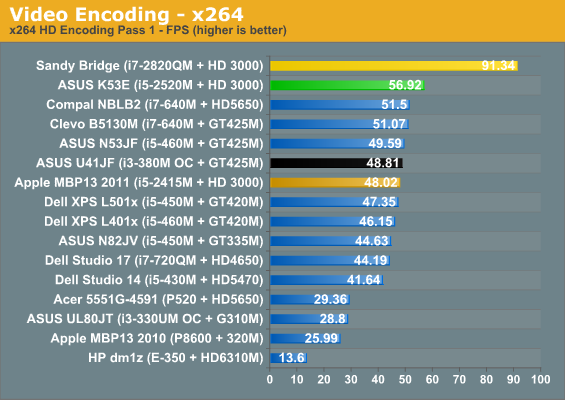

Starting with the new MBP13 comparison, the K53E with i5-2520M comes out an average of 20% faster. Some of that can be attributed to the hard drive differences, as PCMark Vantage shows Apple’s HDD choice is particularly poor, but the CPU intensive tasks are also 15 to 25% faster. It’s interesting that ASUS’ UL41JF happens to put in an overall showing in these applications that matches the MBP13, but that’s in a large part thanks to the 15% overclock. Looking at stock Arrandale CPUs, the i5-2520M turns in slightly higher performance results than the i7-640M, the highest-clocked Arrandale CPU we’ve tested. Even the old i7-720QM in the Dell Studio 17 fails to match the performance of the i5-2520M, which leads by an average of 18% in the above benchmarks (with the only loss coming in Pass 2 of x264 encoding).
Move up to quad-core SNB and an SSD, and of course the dual-core parts look a lot weaker. The i7-2820QM average lead in the above charts is 74%, but part of that is the thanks to the 104% lead in PCMark Vantage. Remove the PCMark results, though, and the 2820QM is still 65% faster than the 2520M. On the other side of the charts—literally—is AMD’s E-350. We know it’s not meant to compete with Sandy Bridge (or even Arrandale or Core 2 Duo), but keep in mind that the cheapest price for such a laptop is going to be around $450. On average, the i5-2520M lays the smack down hard and ends up roughly four times faster than an E-350. Ah, but the E-350 has a much better IGP, right? Well, maybe it’s better, but it’s certainly not faster than Intel’s HD 3000 when it’s bottlenecked by the CPU; here are some 3DMark results before we get to the games to give you an idea of how graphics performance compares.
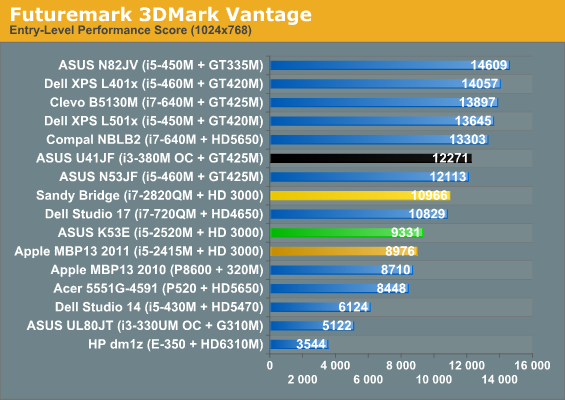
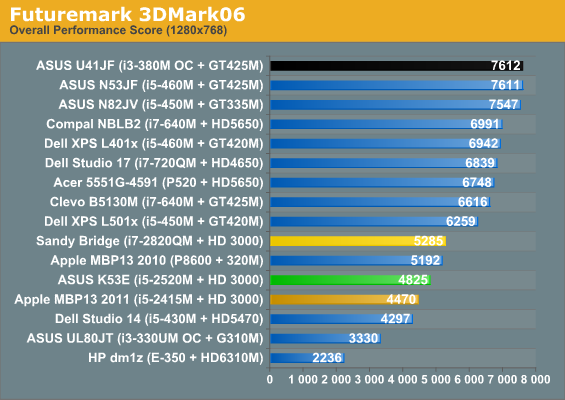
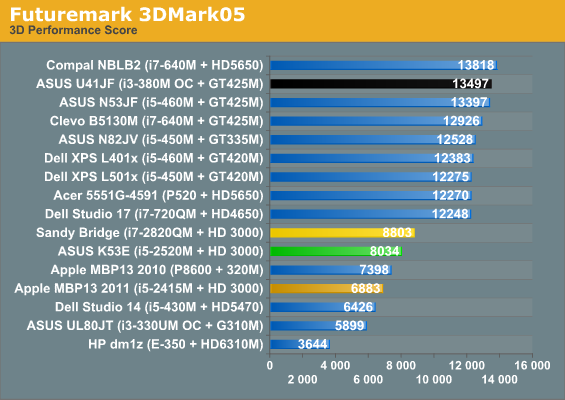
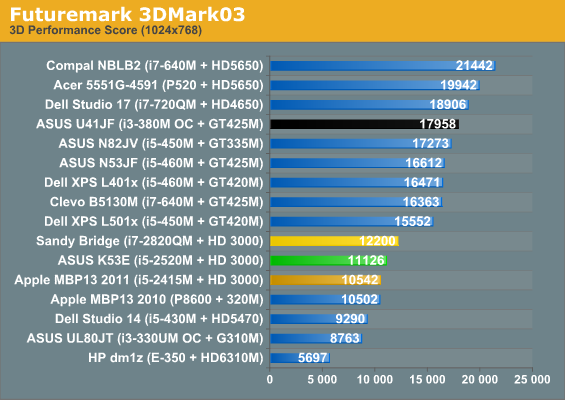
While we would never take 3DMark as the end-all, be-all of graphics performance comparisons, it does give a general idea of what we can expect. The K53E with i5-2520M turns in performance that’s 9% faster than the MBP13 on average across the four versions of 3DMark. That’s actually pretty accurate, as we’ll see in the gaming tests. Likewise, the i7-2820QM results end up being 12% faster than the 2520M, possibly from more aggressive IGP Turbo modes. Again, that matches what we’ll see in the games. On the other hand, even a middling dGPU like the GT 420M/425M still comes out 40-50% ahead of the HD 3000, and AMD’s HD 5650 is 60% faster on average.
What about AMD’s Fusion E-350 platform? If the 3DMark results hold in our actual gaming tests, Intel’s “horrible” HD 3000 IGP offers over twice the performance of the HD 6310M. In fact, even an Arrandale IGP would come within 10% of the E-350 results in 3DMark. It’s not that we love Intel or want them to pummel AMD, and we understand that the E-350 competes in a lower price bracket. Still, many people like to get carried away in discussions of how much better AMD’s graphics are compared to Intel’s IGP. That’s certainly true when you’re looking at discrete GPUs, and compatibility is still better with AMD and NVIDIA drivers, but the latest SNB IGP changed the status quo. HD 3000 works in about 90% of games (roughly estimating), performs well enough to be playable in about 80% of titles, posts scores that are competitive with HD 5470 and GT 320M (and often twice what the current Brazos can achieve), and you get it for free with any 2nd Gen Core i-series CPU. As a friend of mine is fond of saying, it’s hard to compete with “free”.










78 Comments
View All Comments
JarredWalton - Saturday, April 9, 2011 - link
Brazos C-50 starts at $325, so it's within spitting distance of the Atom N550 (dual-core), and it still has a substantially better IGP -- though it's mostly useful for video as opposed to gaming on the C-50. C-50 is also a lower power and better battery life option, though it may not match the best Atom netbooks. Still, I'm not sure most people need more than 10 hours of battery life, which is what we're talking about at this point.AMD's E-350 is better/faster, but it's also more expensive. I'd be quite surprised if Atom netbooks offered better audio latency. Only thing really missing is a good ASUS equivalent of the 1001P, only with C-50. Right now, the only 10.1" C-50 (or Brazos) netbook comes from Acer, who doesn't have the best reputation. If you're interested, though, the Acer Aspire One 522 is on sale for $300 at Micro Center right now.
krumme - Sunday, April 10, 2011 - link
Have you ever tried an Atom? - if i would say you are a very patient man :)There is absolutely none in my family, with very patient female computer users i tell you, who havnt complained about the speed for basic task like surfing and office use.
In my entire life i have met one person who didnt complain - all other - who thought all computers were the same - have complained. Atom just showed them - who did forget about the old age and windows 95 on 8Mb ram, that computer actually can be different.
What i am pretty comfident about is, that all those user would have been pretty sattisfied with an e350, and stayed in their beliewe there was no difference.
I think it just underlines that Intel and AMD have trouble for the future. The cpu/gpu is just fine as they is now. Then there is just the fight for cost, and it means lower earnings on the traditional markets.
strikeback03 - Monday, April 11, 2011 - link
I was perfectly happy with the one Atom system I have used extensively - the carputer I built in my last car was based around an Atom 330. with 1GB RAM and a 200GB 7200 RPM HDD the only time there was ever any delay running the Centrafuse front-end interface was when a module was first loading after a restart. So for limited uses Atom is fine, so long as the software and experience are designed for that level of performance.krumme - Monday, April 11, 2011 - link
Yeaa, and my atom stream audio fine, and does not feel slow as long as i do not touch it.Atom was not build for anything but tv boxes, competing with arm. And therefore it does not work when anandtech, promotes sb at the expense of bobcat, because it indirectly leads the consumers to tv box computer power. And that is the unintended effect of theese articles.
JarredWalton - Monday, April 11, 2011 - link
So Atom running a custom OS will be much better, obviously. Heck, even Atom chips (by PC standards) are going to be twice as fast as the best smartphone chips -- not on the GPU side, though, but that's a different story. But if you were to go out and buy a laptop for use as a Windows PC, there's still a big gap between $400 laptops and $700 laptops -- more than a 2X increase in performance for less than double the price.My experience is that given the choice (i.e. money not a consideration), no one would want less performance from their laptop. SNB dual-core should be good enough to fit in 13.3" laptops that weigh around 4 lbs., and priced at around $800 (or less) that's a great portable PC. Bobcat will go into smaller devices and offer slightly better battery life, but it's still slower (too slow) on some tasks -- e.g. video transcoding, Flash browser games, and anything else that's computationally intensive will be much better on SNB. So again, Brazos is basically for those who value price more than most other areas.
On a related note, I'd be shocked if any major business tried to replace current generation Arrandale laptops with Brazos laptops. Heck, they wouldn't even replace Core 2 Duo laptops with Brazos. Businesses want a balanced laptop, generally speaking, and right now Intel gives you more performance with good battery life for a reasonable price. AMD competes on the desktop and laptop with lower prices, but when productivity is money, why would you save $150 only to have your employees waste hours of time over the next year? (Well, they'll waste time regardless, but they'll waste even *more* time waiting for a slow computer.)
Long-term, it will be very interesting to see what happens with Windows 8. Windows 7 can run on Atom, but it's clearly a different experience than Win7 on even something like CULV or Brazos. ARM-based SoCs are sort of Brazos, except they're even slower on the CPU side of the fence (and slower on GPU as well). Win8 will need some major changes relative to Win7 to make it viable on tablet and laptop devices running such SoCs.
krumme - Tuesday, April 12, 2011 - link
IT is not a strategic subject for top management anymore.A few years back, they would spend time talking TCO, cost outsourcing, but today is different.
They just dont want to hear about it, and spend valuable time on it. For good reason.
SAP is running for everyone and his brother, the oursourcing is in place. Who cares if its a Dell or HP machine except in IT.
And the IT director, who ofen is an economis, hardly knows what a CPU is. It matters so little no one cares just a few stop up the chain.
The replacement of computers is just done regulary say every 3 years, and what Dell/HP chooses to put in their computers is their business.
If something is interesting about the computers today its screen, keyboard, battery and foremost quality.
The cost differences for a brazos compared to a sb is so slim, it doesnt matter. But lets say the next brazos 28nm q4?, have nearly double the batterylife and a solid turbo, then i think there is a chance we will se a lot of ultra portable business laptops with them.
Except for 10% of the business users i think we are waiting for the HD not the cpu. Therefore i think we will se more cheap ssd and even more noise and battery friendly cpu/gpu in the next generation - standard roll out - business leasing deals.
But as said, for the professional side its just mostly TCO today, and for the consumer side its just more and more cost, cost, cost. Perhaps they are saving for an IPAD3 ? :)
tomycs2007 - Monday, April 11, 2011 - link
"15.6" WLED Glossy 16:9 768p (1366x768)(AU Optronics B156XW02 v6)"
TegiriNenashi - Monday, April 11, 2011 - link
As long as its display has puny vertical 768 pixels resolution. Please bring back 16:10 aspect ratio!